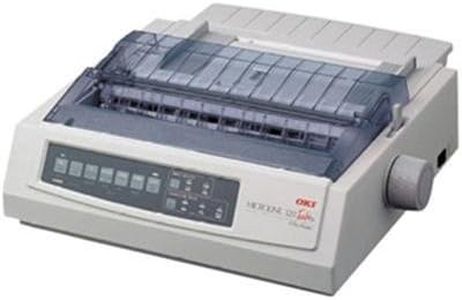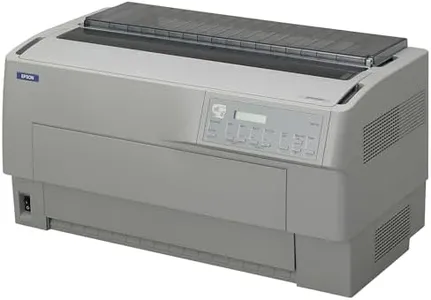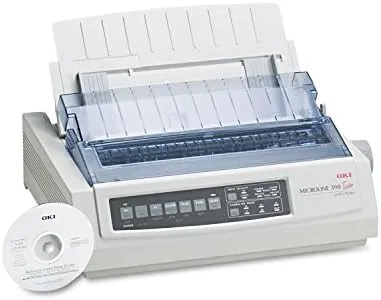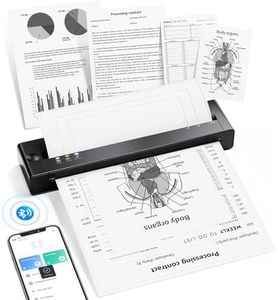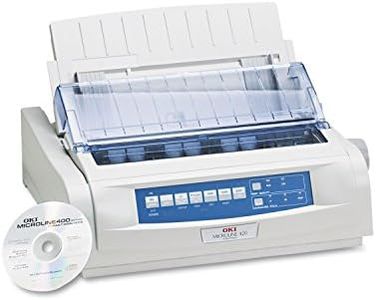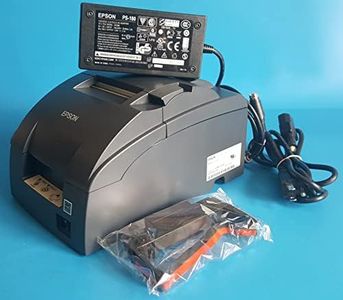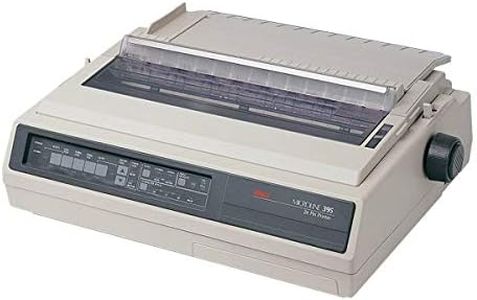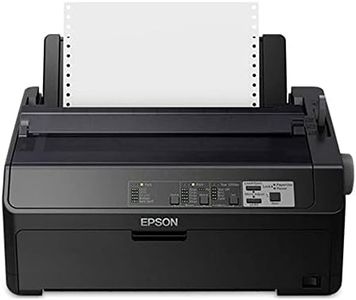10 Best Dot Matrix Printers 2025 in the United States
Our technology thoroughly searches through the online shopping world, reviewing hundreds of sites. We then process and analyze this information, updating in real-time to bring you the latest top-rated products. This way, you always get the best and most current options available.

Our Top Picks
Winner
Oki Microline 320 Turbo/N Dot Matrix Printer "Prod. Type: Printers Dot Matrix/Printer"
The Oki Microline 320 Turbo/N Dot Matrix Printer is a robust and reliable choice, suitable for high-volume printing needs, such as point-of-sale, automation, and utility applications. It boasts a generous max input sheet capacity of 1000 sheets, making it ideal for offices that require continuous printing without frequent paper reloading. The print quality is monochrome with a max resolution of 240 x 216 dpi, which is typical for dot-matrix printers, sufficient for text-based documents but less suited for graphics-heavy printing tasks.
Connectivity options include a USB port, and it is network-ready, allowing for seamless integration into most office environments. However, it is limited by only having one USB port and lacks wireless connectivity options, which could be a drawback for more modern office setups. Weighing 16.8 pounds, it is relatively portable despite being a sturdy piece of equipment. The printer is known for its durability and reliability, essential for businesses that depend on consistent performance.
One potential downside is the noise level, as dot-matrix printers are generally noisier compared to other types of printers. Additionally, this model does not support dual-sided printing, which could be a consideration for those looking to save paper. The Oki Microline 320 Turbo/N Dot Matrix Printer is best suited for businesses needing a dependable, high-capacity printer for text-heavy documents.
Epson 9-PIN Dot Matrix Wide DFX-9000
Most important from
10 reviews
The Epson 9-PIN Dot Matrix Wide DFX-9000 is designed for businesses needing efficient printing of reports, multipart forms, and labels. One of its standout features is its ultra-fast print speed of up to 1550 characters per second, making it suitable for high-volume tasks. Additionally, the automatic platen gap adjustment and jam-sensor help minimize paper waste, enhancing productivity.
Durability is another strong point, as the print head boasts a lifespan of 400 million characters and the ribbon cartridge lasts for 15 million characters, which can significantly lower the long-term costs of printing. The included LCD display simplifies setup and menu navigation, making the printer user-friendly even for those who might not be tech-savvy.
On the downside, the DFX-9000 is quite large and weighs around 3.75 pounds, which may require a dedicated space in an office environment. Its noise level can also be higher than that of modern printers, which might be distracting in quieter office settings. While it offers good connectivity with a USB port, it lacks the versatility of wireless options that many newer printers provide. The print quality is generally acceptable for monochrome outputs, but it may not meet the expectations of users seeking high-resolution color printing, as this is not the focus of a dot matrix printer. The limited maximum input sheet capacity of 9 sheets might also pose a challenge for some users who frequently handle larger print jobs.
The Epson DFX-9000 serves as a robust choice for environments where speed, durability, and cost-effectiveness are essential, though it may not cater to users looking for modern features or quiet operation.
Most important from
10 reviews
Oki 62434101 MICROLINE 691 Dot Matrix Printer
Most important from
3 reviews
The Oki 62434101 MICROLINE 691 Dot Matrix Printer is a solid choice for businesses that require reliable, high-volume printing tasks. Its 24-pin technology ensures decent print quality, with a resolution of 360 x 360 dpi, making it suitable for printing clear text documents. The print speed of 480 characters per second (cps) is relatively fast for a dot matrix printer, which can boost productivity for large print jobs.
The printer's duty cycle of up to 14,000 pages per month indicates a robust design, capable of handling substantial workloads with reliability. With connectivity options including Parallel and USB, it is quite versatile and can be easily integrated into various office setups. Additionally, its Energy Star certification suggests it's energy-efficient, which can help reduce operating costs.
However, it is important to note that the printer's monochrome output limits its use to text and simple graphics, which might not be suitable for users requiring detailed color prints. Its noise level might be higher compared to modern inkjet or laser printers, which could be a drawback in quieter office environments. The printer's relatively bulky size (27 x 20 x 11 inches) and weight (27.55 pounds) may also require significant desk or floor space. Despite these limitations, the Oki 62434101 MICROLINE 691 is a reliable and durable option for businesses in need of an efficient dot matrix printer, particularly in environments that demand high-volume, monochrome printing.
Most important from
3 reviews
Buying Guide for the Best Dot Matrix Printers
Dot-matrix printers are a type of impact printer that use a print head to strike an ink-soaked ribbon against the paper, creating characters and images out of dots. They are known for their durability and ability to print on multi-part forms, making them ideal for certain business applications. When choosing a dot-matrix printer, it's important to consider several key specifications to ensure you select the best model for your needs.FAQ
Most Popular Categories Right Now
